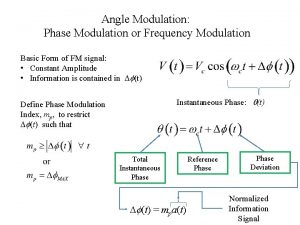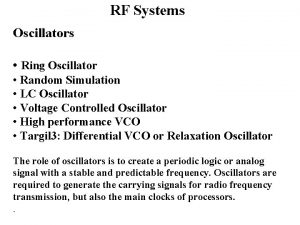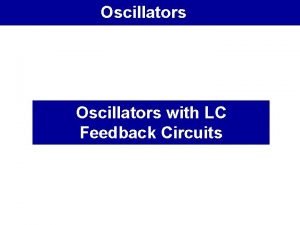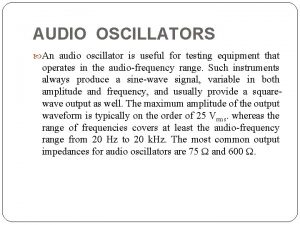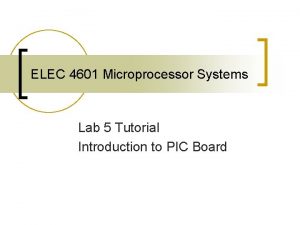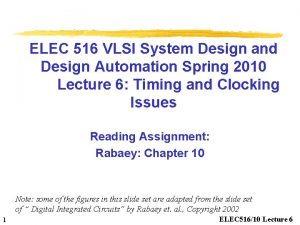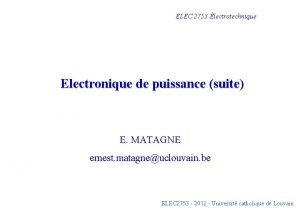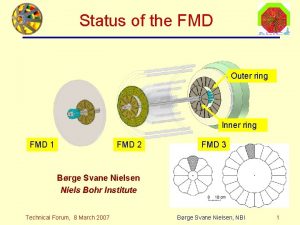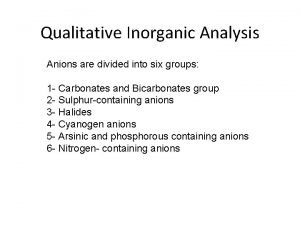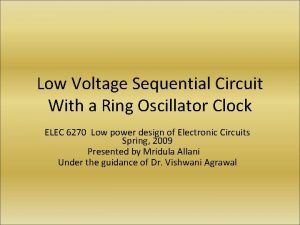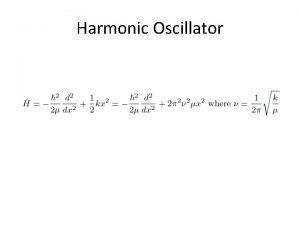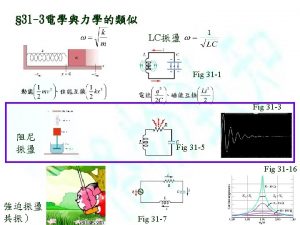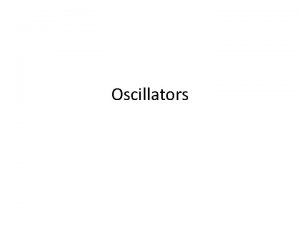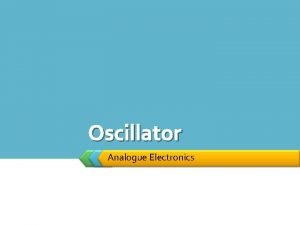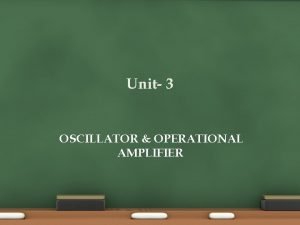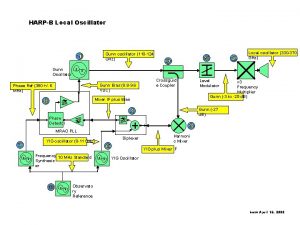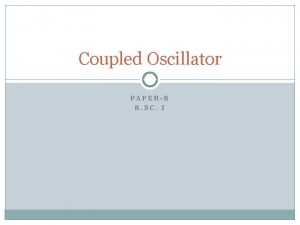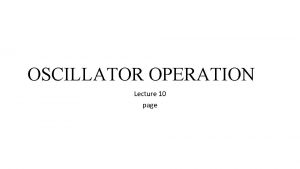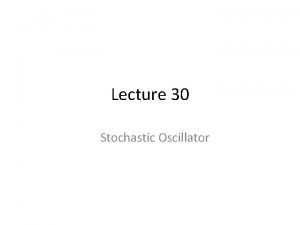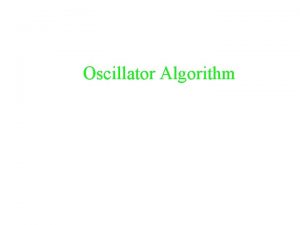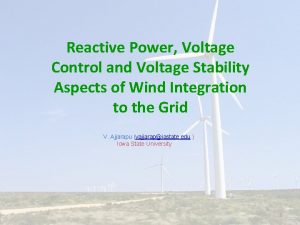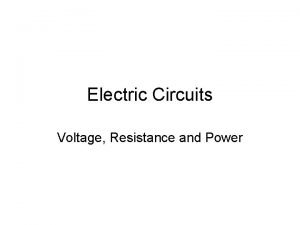Ring Oscillator Power and Frequency Vs Voltage ELEC

























- Slides: 25

Ring Oscillator Power and Frequency Vs Voltage ELEC 6270 Low power design of Electronic Circuits Advisor: Dr. Vishwani Agrawal Student: Chaitanya Bandi

Index �Ring Oscillator Operation �Tools Used �Schematic �Power and Frequency Versus Voltage (Expected and Observed) for different values of N (where N is the number of gates). �References

Ring Oscillator �A ring oscillator is a device composed of an odd number of NOT gates whose output oscillates between two voltage levels, representing 1 and 0. � The NOT gates, or inverters, are attached in a chain; the output of the last inverter is fed back into the first

Tools Used �Design Architect: To create and Edit the Schematic �Eldo: To find the Frequency of oscillations and Average Power consumed

Schematic from Design Architect Ringin: input pin to initialize the oscillations Ringout: output pin from at which oscillations are observed

Simulation results of the Ring oscillator from ELDO for N=11 Vdd= 4 v Vdd= 5 v

Vdd = 3 v Vdd=2 v

Vdd= 1 v Vdd =. 9 v

Vdd=. 85 v Vdd=. 815

Rise time & Fall Time Vs Voltage Vdd (volts) Rise time fall time 5 0. 08 ns 0. 07 ns 4 0. 10 ns 0. 07 ns 3 0. 11 ns 0. 1 ns 2 0. 2 ns 0. 1 ns 1 0. 8 ns 0. 34 ns 0. 9 1. 73 n 0. 76 ns 0. 85 3. 2 ns 0. 815 5. 21 ns 1. 83 ns N=11 The rise times and fall times of the oscillator increases with a decrease in supply voltage which indicates that the delay of the gates increases with a decrease in the supply voltage.

For N=11, Power & Freq Vs Voltage Vdd (Volts) Frequency Power 5 826 MHz 3. 382 m. W 4 698 MHz 1. 7 m. W 3 562 MHz 702 u. W 2 367 MHz 187 u. W 1 64. 9 MHz 6 u. W 0. 85 19 MHz 1. 18 u. W

For N=19, Power & Freq Vs Voltage Vdd (Volts) Frequency Power 5 826 MHz 6. 61 m. W 4 698 MHz 2. 93 m. W 3 562 MHz 1. 212 m. W 2 367 MHz 323 u. W 1 64. 9 MHz 10. 36 u. W 0. 85 19 MHz 2. 038 u. W

For N=5, Power & Freq Vs Voltage Vdd(Volts) Frequency Power 5 2. 1 GHz 1. 57 m. W 4 1. 818 GHz 0. 788 m. W 3 1. 43 GHz 330 u. W 2 . 952 GHz 87 uw 1 168 MHz 2. 89 u. W 0. 85 50 MHz . 54 u. W

N=19, 11, 5 Power Vs Voltage 7000 6000 5000 Average power(μW)(N=11) 4000 Average power(μW)(N=19) 3000 Average power(μW)(N=5) 2000 1000 0 0 1 2 3 4 X-Axis: Voltage(Volts) 5 6 Y-Axis: Power(u. W)

N=19, 11, 5 Frequency Vs Voltage

Power Vs number of gates(N) 7000 Average power for V=5 V 6000 5000 4000 Average power for V=5 V 3000 2000 1000 0 0 5 10 15 As the number of gates increases the Average power increases proportionally. X-axis: Number of gates 20 Y-axis: Average Power

Expected Power and Frequency 1) Power α f* (Vdd) ^2 ; where f is the observed frequency 2) Delay of Each gate α (Vdd)/(Vdd-Vth) Vth = 0. 54 v for tsmc 035 technology

Average power & Expected Power N=11 Vdd(volts) average power Expected Power 5 3. 414 m. W 4 1. 718 m. W 1. 845 m. W 3 . 711 m. W 0. 846 m. W 2 . 191 m. W 0. 246. 5 m. W 1 6. 33 u. W 10. 67 u. W 0. 85 1. 173 u. W 2. 322 u. W 0. 6 5. 2 n. W 11. 5 n. W

Average power & Expected Power N=19 Vdd(volts) Average Power Expected Power 5 6. 61 m. W 4 2. 93 m. W 3. 600 m. W 3 1. 212 m. W 1. 571 m. W 2 323 u. W 466. 52 u. W 1 10. 36 u. W 20. 43 u. W 0. 85 2. 038 u. W 4. 37 u. W

Average power & Expected Power N=5 Vdd(volts) Average Power Expected Power 5 1. 57 m. W 4 0. 788 m. W 1. 087 m. W 3 330 u. W 645. 54 u. W 2 87 uw 284. 69 u. W 1 2. 89 u. W 25. 12 u. W 0. 85 . 54 u. W 6. 33 uw

Observed & Expected Frequency N=11 VDD (Volts) frequency Expected Frequency 5 1. 389 GHz - 4 1. 176 GHz 1. 34 Ghz 3 0. 956 GHz 1. 277 Ghz 2 . 627 GHz 1. 136 Ghz 1 . 109 GHz . 716 GHz 0. 85 . 0327 GHz . 568 GHz 0. 6 0. 326 MHz . 155 GHz

Observed & Expected Frequency N=19 Vdd(Volts) Freq Expected Freq 5 826 MHz 4 698 MHz 800. 9 MHz 3 562 MHz 759. 3 MHz 2 367 MHz 675. 8 MHz 1 64. 9 MHz 425. 9 MHz 0. 85 19 MHz 337. 7 MHz

Observed & Expected Frequency N=5 VDD(volts) Freq Expected Freq 5 2. 1 GHz 4 1. 818 GHz 2. 036 GHz 3 1. 43 GHz 1. 93 GHz 2 . 952 Ghz 1. 718 GHz 1 168 MHz 1. 08 GHz 0. 85 50 MHz 858 MHz

Observations • If the Vdd is changed from 5 v to 0. 85 V there is a power reduction of about 99. 9%, but the frequency of oscillations is decreased by 76%. • The Frequency of oscillations decreases as the number of gates in the oscillator increases. • The Power consumption increases in proportion to the number of gates in the oscillator. • The Observed frequencies are lesser than the expected frequencies due to large delays in the gates at low operating voltages.

References: 1. Fall 2007: ELEC 6270 Low Power Design Electronics Class Slides from Dr. Agrawal 2. Fall 2007: ELEC 6250 Computer Aided Design of Digital Logic Circuits Lectures 4, 23 from Dr. Nelson’s Class slides. 3. http: //www. iue. tuwien. ac. at/phd/martins/node 46. html
 Voltage controlled oscillator
Voltage controlled oscillator Lc oscillator simulation
Lc oscillator simulation Colpitts oscillator frequency formula
Colpitts oscillator frequency formula What is audio oscillator
What is audio oscillator Power formula three phase
Power formula three phase The objectives of earthing is
The objectives of earthing is Convert rms to peak to peak
Convert rms to peak to peak Elec 4601
Elec 4601 Elec4601
Elec4601 Elec service plus
Elec service plus Pattern recognition
Pattern recognition Elec
Elec Elec
Elec Elec
Elec Superposition electric circuits
Superposition electric circuits Strong no in c
Strong no in c Inner ring and outer ring
Inner ring and outer ring Resilient packet ring
Resilient packet ring Medium voltage
Medium voltage Ac voltage controllers
Ac voltage controllers Pulse doppler radar vs mti
Pulse doppler radar vs mti Analysis of anions
Analysis of anions Superfacial inguinal ring
Superfacial inguinal ring Shutter mechanism of internal oblique
Shutter mechanism of internal oblique Merrily merrily christmas bells are ringing
Merrily merrily christmas bells are ringing Ring christmas bells ring them loud
Ring christmas bells ring them loud
